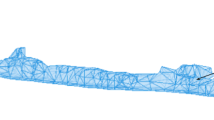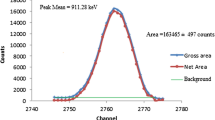Abstract
In situ gamma-ray measurements were taken at six locations in the Modane Underground Laboratory. Count rates for gamma radiation within the energy range of 7–2734 keV varied from 15 to 108 γs−1. The arithmetic mean was 79 γs−1 for measurements taken without a collimator. The metamorphic rocks surrounding the Lab are characterized by low activity concentrations of uranium and thorium equal to 12 and 10 Bq kg−1, respectively.
Similar content being viewed by others
Explore related subjects
Discover the latest articles, news and stories from top researchers in related subjects.Avoid common mistakes on your manuscript.
Introduction
The Modane Underground Laboratory (Laboratoire Souterrain de Modane – LSM) is one of the largest underground research centers in Europe. The Laboratory is located in the highway tunnel connecting France and Italy, 1,200 m a.s.l. Including main hall and three secondary halls, the total volume and area of the Lab are 3.52 × 103 m3 and 4.1 × 102 m2 [1, 2]. The scientific programs at LSM comprise particle and astroparticle physics, neutrinoless double beta decay, and ultra-low background experiments [3]. As all these experiments represent investigations of extremely rare events the precise determination of the natural radioactivity background level is required [4, 5]. After cosmic rays, the most important sources of background radiation are the decays of primordial radionuclides such as 40K, 232Th, and 238U in rocks, concrete, and the construction materials used in the detectors. The neutrons originating from (α,n) reactions and the spontaneous fission of U and Th are the main sources of background radiation which can imitate some of the expected signals from the experiments. In this paper we present results of in situ gamma-ray measurements in LSM which were performed in 2006, and laboratory measurements of the parent rock and concrete covering the halls.
Materials and methods
The background gamma radiation in LSM was measured in situ using a portable gamma-ray spectrometry workstation (Fig. 1). The GX3020 system consisted of a coaxial HPGe detector (32% efficiency, crystal length 59 mm and diameter 56.6 mm) with a cryostat mounted on a tripod or a special table, a collimator 50 × 180 mm, a multichannel buffer (InSpector 2000 DSP), and a laptop. The detector bias voltage was 4,000 V and the energy resolution was 0.8 keV at 122 keV and 1.7 keV at 1.33 MeV. For the efficiency calibration and determination of radionuclides the ISOCS (In Situ Object Counting Software), LabSOCS (Laboratory Sourceless Calibration Software) and Genie 2000 v.3 software packages were used. The total duration of a single measurement varied from about 19 to 42 h (Table 1).
Samples of calcschist (parent rock) and concrete were collected from the main hall, and several months after collection they were measured using the same GX3020 HPGe detector in a lead and copper shield (60 mm). The spectrometer energy was calibrated using homogeneously dispersed 241Am, 109Cd, 139Ce, 57Co, 60Co, 137Cs, 113Sn, 85Sr, 88Y and 203Hg radioisotopes in a silicone resin (certificate source type Marinelli Beaker Standard Source [MBSS], supplied by the Czech Metrological Institute). The measurements were done at the Laboratory of Natural Radioactivity (Faculty of Earth Sciences, University of Silesia).
Location of in situ measurements
Measurement location 1 was chosen in front of the NEMO 3 experiment (Fig. 1, location 1). The end cap of the detector was 90 cm above the concrete base, 3.7 m away from the NEMO 3 construction and 5.40 m from the side wall. Location 2 was the same as the first, except the detector with a collimator was mounted horizontally 1 m from NEMO 3 construction (Fig. 1, location 2). Measurement location 3 was located in the power supply room on the upper level of the Lab. The detector with a collimator was mounted horizontally directly near the wall and 90 cm above the floor (Fig. 1, location 3). Measurement location 4 was located in the gamma detectors’ hall (Fig. 1, location 4). The detector was mounted 90 cm above the floor, 2.8 m from the side walls and 9 m away from the entrance to the hall. Location 5 was the same as 4, except the detector was mounted horizontally directly near the wall and 90 cm above the floor (Fig. 1, location 5). The last measuring point (location 6) was on a metal platform in front of the NEMO 3 experiment. The detector was mounted horizontally 90 cm above the platform and 5 m away from the NEMO 3 construction (Fig. 1, location 6). The gamma-ray spectra from all locations are presented in Fig. 2.
Results and discussion
The count rates (γ s−1) at all measurement locations are listed in Table 1, and the gamma fluxes in γ cm−2 s−1 from locations 2 and 3 are given in Table 2. The count rates in the main gamma peaks and the gamma fluxes from these peaks at locations 2 and 3 are presented in Tables 3 and 4, respectively. Table 5 summarizes the results of the activity measurements in the parent rock and in concrete from the main hall.
In situ measurements
The total count rates between energy range of 7.4–2734.2 keV varied from 15 at location 2 to ~108 γ s−1 at location 5 (Table 1). The arithmetic mean for measurements without a collimator (locations 1, 4, 5 and 6) was 79(23) γ s−1 (Fig. 3a). As expected the highest count rates were noted between 7.4 and 249.8 keV with an average contribution of 0.65 for all measurement locations (Fig. 3b). The count rates at subsequent energy ranges noticeably decreased, with average contributions of 0.17, 0.11, 0.05, 1.1 × 10−2, and 7 × 10−3 within ranges 250–500, 501–1005, 1,006–1,556, 1,556–2,056, and 2,056–2,734 keV, respectively (Fig. 3b). The lowest count rates (both with and without a collimator) at locations 2 and 6 indicate that the metal elements inside the Lab show the smallest contribution to the total background.
For measurements using a collimator (locations 2 and 3) the highest total gamma flux, 0.622 γ cm−2 s−1, was noted at location 3. At location 2 the total gamma flux, 0.301 γ cm−2 s−1, was two times lower than at location 3 (Table 2). Similar to the count rates, the particular contributions of these gamma fluxes rapidly decrease with increasing energy; they are on the order of 10−2 in the range 250–1,556 keV, and 10−3 in the range 1556–2734 keV. The highest integral areas from the main gamma transitions (except point 2) were noted under the peak at 351.9 keV (214Pb) and then under the peaks at 609.3 (214Bi) and 1460.8 keV (40K) (Table 3). The two most intense gamma transitions from thorium series i.e., 911.6 keV (228Ac) and 2614.5 keV (208Tl) are characterized by reduced areas compared with lines of 351.9, 609.3 and 1460.8 keV. The gamma transition of 2204.2 keV from 214Bi is characterized by the lowest count rates ranging from 0.03 γ s−1 at location 6 to 0.06 γ s−1 at location 5 (measurements without a collimator). Despite the low yield (1.28%) of the 2,204.2 keV transition [6], its contribution may be important to geo-neutrino experiments because its possible overlap with the deuteron binding energy of 2.2 MeV [7]. This energy is released as gamma rays as a result of inverse beta-decay in a liquid scintillator.
Gamma fluxes at locations 2 and 3 (measurements with a collimator) are on the order of 10−3 γ cm−2 s−1 for the peaks at 351.9, 609.3 and 1460.8 keV, and on the order of 10−4 γ cm−2 s−1 for the peaks at 911.6, 2204.2 and 2614.5 keV (Table 4).
The gamma rays emitted from calibration sources as 137Cs (peak 661.6 keV) and 60Co (peaks 1,173.2 and 1,332.5 keV) [8] are visible in the spectra at locations 1, 4, 5 and 6. The count rates in these peaks varied from 0.071 (location 6) to 0.088 γ s−1 (locations 1 and 5), and 0.064 (location 6) to 0.305 γ s−1 (location 4) for 137Cs and 60Co, respectively. The values for 60Co are given as the sum of peaks 1173.2 and 1332.5 keV.
Laboratory measurements
The results of the activity measurements for calcschist (Fig. 4) and concrete collected from the main hall are given in Table 5. As seen the table, the activity concentration in Bq kg−1 and the concentration in 10−6 gg−1 of 238U is two times higher in concrete than in calcschist, whereas 40K concentrations in Bq kg−1 and 10−6 gg−1 in calcschist is two times higher than in concrete. The activity concentrations of 232Th are comparable (Table 5). Activity concentrations of 40K, 232Th and 238U equal to 213(30), 10.1(8) and 10.4(25) Bq kg−1, respectively, have been reported in calcschist, and concentrations equal to 77(13), 5.8(8) and 23.5(25), respectively, have been noted in concrete in LSM by Chazal et al. (1998) [9]. These values are consistent with the results obtained in our measurements. Generally, the concrete covering walls in LSM shows activity concentrations of 40K, 232Th and 238U comparable with concentrations observed for typical limestone concretes i.e., 89, 8.5 and 31 Bq kg−1, respectively [10]. The activity concentrations of 40K, 232Th and 238U directly calculated during in situ measurement (location 3) were 19.7(7), 6.2(2) and 80(1) Bq kg−1, respectively. These results indicate that the most important sources of gamma background inside the Lab are decays of primordial radionuclides in limestone concrete that covers the parent rock.
Conclusions
The gamma background inside the Laboratoire Souterrain de Modane is low and characterized by count rates at the level of 79 γ s−1 in the energy range of 7–2734 keV. Gamma fluxes obtained from two locations were 0.301 and 0.622 γ cm−2 s−1. The construction materials inside the Lab do not contribute significantly to the total gamma background.
References
Miramonti L (2005) European underground laboratories: an overview. arXiv:hep-ex/0503054v1
Loaiza P (2005) Low radioactivity at the Modane underground laboratory in topical workshop on low radioactivity techniques, edited by Cleveland B, Ford R, and Chen M (American Institute of Physics), pp 100–103
Aalseth C, Andreotti E, Dirk Arnold D, Sanchez Cabeza JA, Degering D, Giuliani A, Gonzales de Orduna R, Gurriaran R, Mikael Hult M, Keillor M, Laubenstein M, Le Petit G, Margineanu RM, Matthews M, Miley H, Osvath I, Pellicciari M, Plastino W, Simgen H, Weber M, Werzi R (2009) Ultra-low background measurements of decayed aerosol filters. J Radioanal Nucl Chem 282:731–735
Miramonti L (2002) A very low background HPGe detector operating deep underground at 4,800 m water equivalent. Appl Radiat Isot 57:209–212
Niese S, Koehler M, Gleisberg B (1998) Low-level counting techniques in the underground laboratory Felsenkeller in Dresden. J Radioanal Nucl Chem 233:167–172
Firestone RB (1996) Table of isotopes. Wiley-Interscience, Lawrence Berkeley National Laboratory, Berkeley
Dye ST (ed) (2006) Neutrino geophysics. Springer, Dordrecht
Debertin K, Helmer RG (1988) Gamma–and X-Ray spectrometry with semiconductor detectors. Elsevier Science Publishers, Amsterdam
Chazal V, Brissot R, Cavaignac JF, Chambon B, De Jesus M, Drain D, Giraud-Heraud Y, Pastor C, Stutz A, Vagneron L (1998) Neutron background measurements in the underground laboratory of Modane. Astrop Phys 9:163–172
Eisenbud M, Gesell T (1997) Environmental radioactivity from natural, industrial, and military sources. Academic Press, San Diego, pp 134–200
Acknowledgment
This publication was supported by EU funds under the contract ILIAS RII3-CT-2004-506222.
Open Access
This article is distributed under the terms of the Creative Commons Attribution Noncommercial License which permits any noncommercial use, distribution, and reproduction in any medium, provided the original author(s) and source are credited.
Author information
Authors and Affiliations
Corresponding author
Rights and permissions
Open Access This is an open access article distributed under the terms of the Creative Commons Attribution Noncommercial License (https://creativecommons.org/licenses/by-nc/2.0), which permits any noncommercial use, distribution, and reproduction in any medium, provided the original author(s) and source are credited.
About this article
Cite this article
Malczewski, D., Kisiel, J. & Dorda, J. Gamma background measurements in the Laboratoire Souterrain de Modane. J Radioanal Nucl Chem 292, 751–756 (2012). https://doi.org/10.1007/s10967-011-1497-9
Received:
Published:
Issue Date:
DOI: https://doi.org/10.1007/s10967-011-1497-9








